How to Make Dried Lemon Zest (or Peels)
Dried lemon zest is a convenient and versatile ingredient. And it is super easy to make. Learn how to dry fine lemon zest, whole slices of lemon peel, or make dry lemon peel powder. Use it in seasonings, marinades, dressings and cocktails.
Once you realise how incredibly easy it is to dry lemon zest at home, you will never squeeze another lemon without saving the rind first.
I use lemon zest in many recipes, and having dried lemon zest ready to go is such a convenience.
Mix your dried citrus zest with sea salt flakes for a delicious citrus seasoning. Use a spice grinder to blitz dried lemon rind into lemon peel powder or make homemade lemon pepper seasoning. You can also use it as a substitute for fresh lemon zest in recipes.
And it need not end with lemons. Why not add some mandarin or grapefruit zest to the mix while winter citrus is available in abundance?
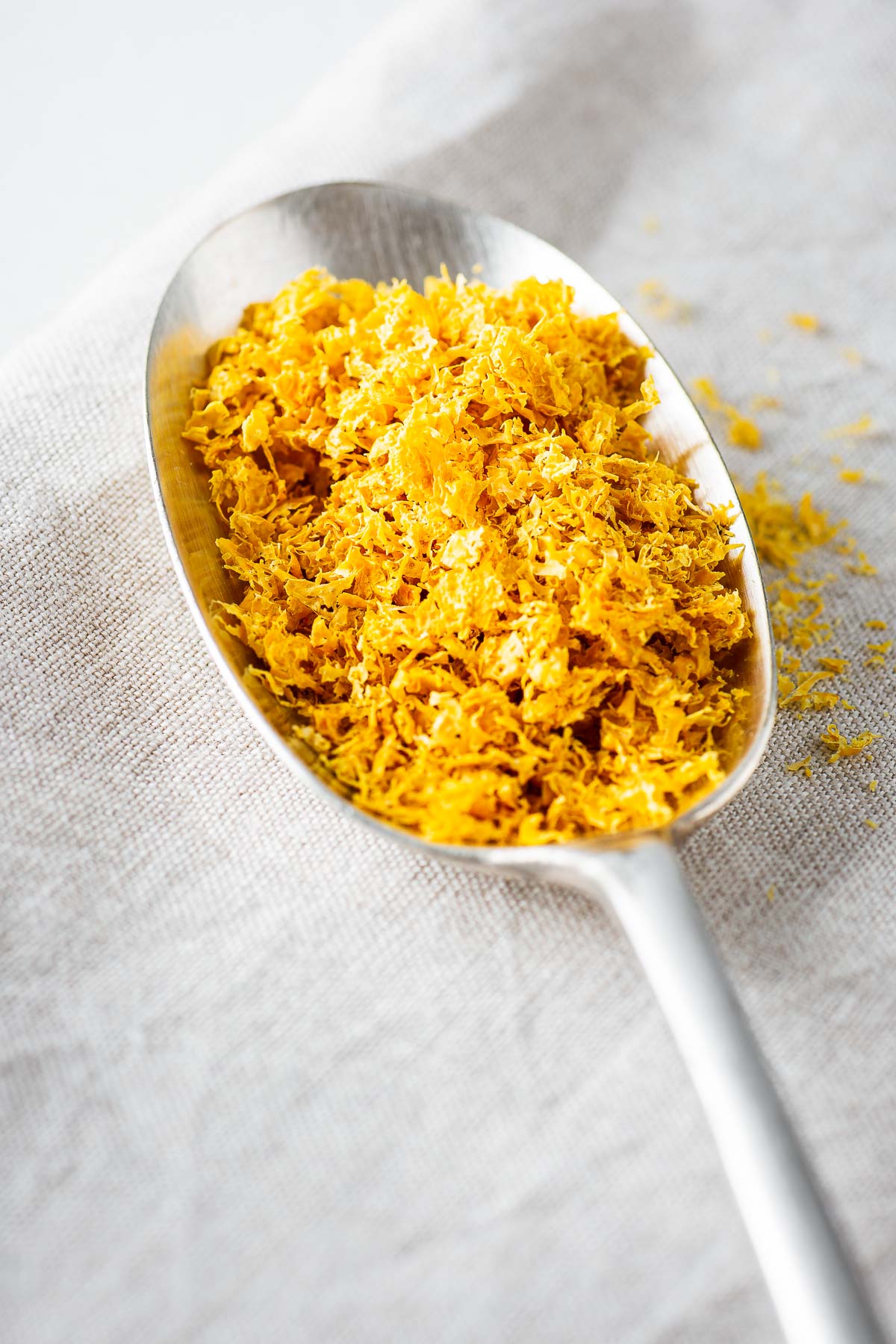
Why you’ll love homemade dried lemon zest
Drying lemon rind is a great way to use all the citrusy goodness from your fresh lemons.
And not only do you avoid wastefulness, but you also have convenient dried lemon zest ready to use in dressings, marinades and other recipes.
If you have an oversupply of lemons, use the oven drying method to quickly dry a large batch of lemon zest or lemon peel.
But, you also don’t need to zest a large batch of lemons. Leave fresh lemon zest from one lemon in a sunny spot to air dry. And speed up the air drying with residual oven heat after cooking.
Tip: Keep a jar of dried lemon zest in your spice cabinet and top it up with new batches. Label your spice jar with the date and keep topping it up for up to one year.
See the recipe card for how to dry lemon rind in the oven or sun. Or keep reading for more tips and tricks.
How to make dried lemon zest (or lemon peels)
The first step is to clean the lemons. If you have shop-bought lemons, this means getting rid of the wax coating first.
Once cleaned, it is as simple as zesting the lemon – or removing the lemon peel with a sharp knife – and dehydrating it in the oven, a dehydrator or a sunny spot by a closed window.
- Step 1: Wash and dewax shop-bought lemons
- Step 2: Zest or strip the lemon peel
- Step 3: Dry the lemon zest or peels
Clean your lemons before zesting
If you have homegrown lemons or unwaxed organic lemons, you can rinse the lemons with tap water to remove dust and dirt.
But shop-bought lemons often have a wax coating to keep the skin looking fresh and shiny. It is best to remove most of this wax coating even though the thin layer of wax is safe to consume.
Luckily, it’s easy to remove the wax coating of shop-bought citrus fruit at home.
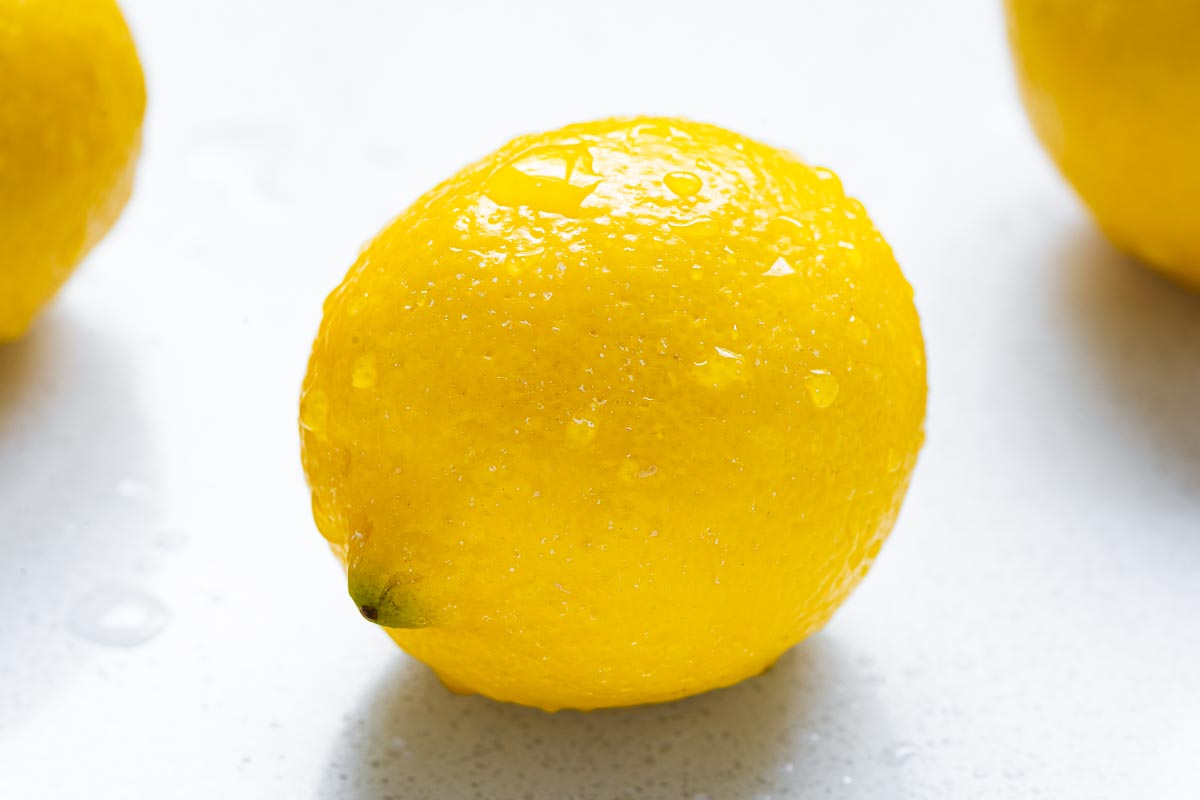
How to dewax a lemon
The easiest way to remove the wax coating from citrus fruit is to clean it with hot (or boiling) water.
Place the fruit in a colander or mesh strainer and pour recently boiled water or very hot tap water over the fruit. Scrub the fruit with a vegetable brush or another clean stiff brush. Rinse the scrubbed fruit with cool tap water.
Rub the fruit dry with a clean kitchen towel or paper towel.
How to peel or zest a lemon for drying
My preferred lemon zesting tool is a classic Microplane zester. But a cocktail zester or the fine side of a box grater also works.
Aim to remove the yellow peel without too much bitter pith. The pith is the white part between the yellow skin and the juicy lemon flesh.
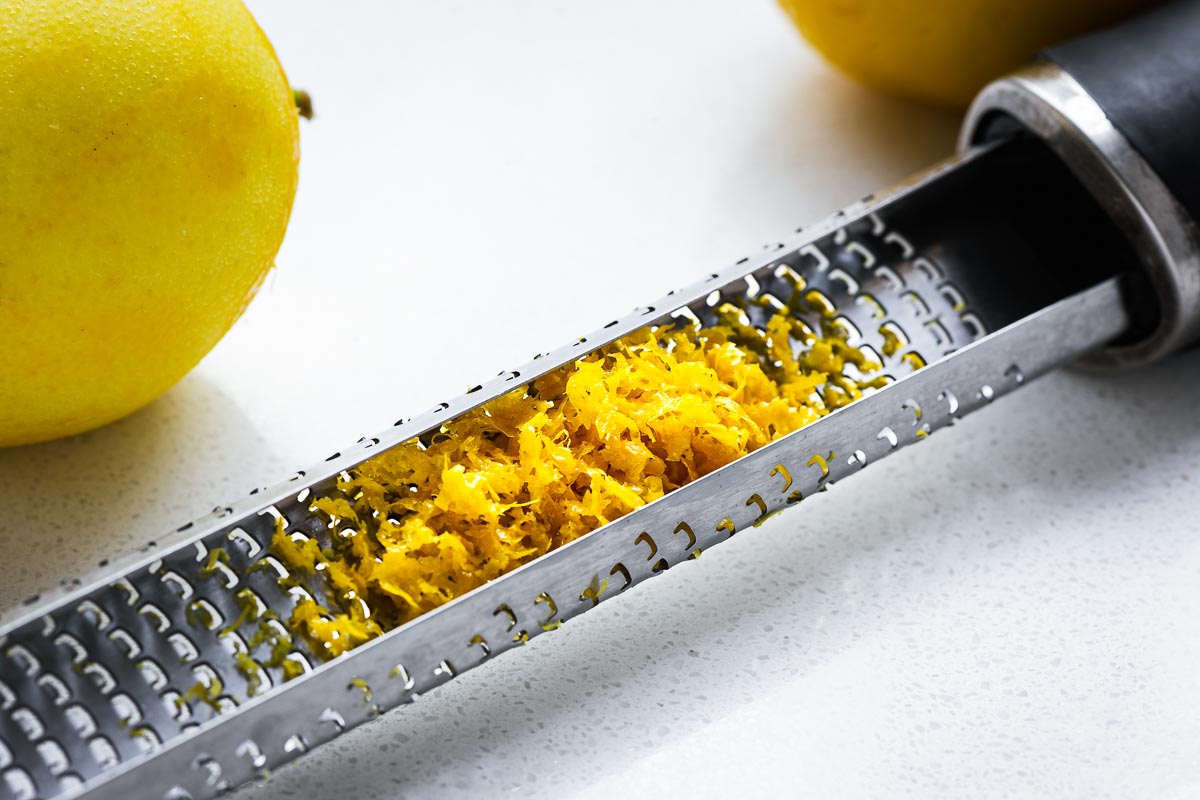
You can also zest other citrus fruit like mandarins, clementines, grapefruits, and makrut limes. Use the same steps to zest any citrus fruit and combine your dried citrus zest for unique and flavourful citrus seasoning mixes.
If you don’t have a zester or fine grater, you can use a sharp pairing knife to strip the yellow peel from the lemon. Place each piece of lemon peel on a cutting board with the white pith facing up, and use your knife to scrape away most of the white. No need to be obsessive here – just remove most of the white to avoid its bitter taste.
You can dry these pieces of lemon peel whole, but large lemon rinds take longer to dry (two to three hours in the oven). Or finely dice the lemon peel to speed up drying time.
How to dry lemon zest or lemon peel
Spread the lemon zest or peels (without too much white pith) in a single layer on a baking sheet lined with parchment paper.
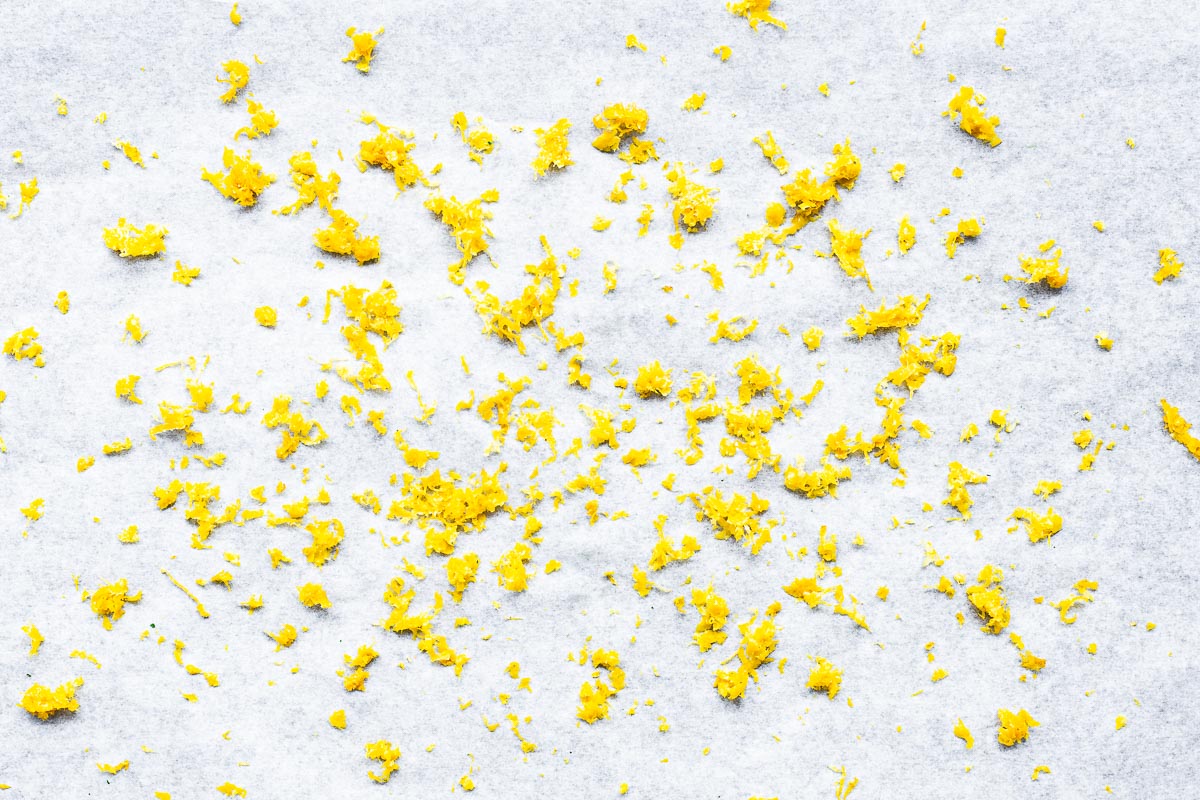
You can either air-dry the lemon skin or use the oven (or a dehydrator) to speed up the process.
Depending on the drying method and the thickness of the lemon skins, it can take 30 minutes to a week for the lemon peel to completely dry out.
Oven-dried lemon zest (or peel)
Preheat the oven to 170 ºF (75 ºC) fan. If you don’t have a fan-assisted oven (convection oven), increase the temperature to 200 ºF (95 ºC). Or if your fan oven can’t go down to 170 ºF (75 ºC), use the lowest setting for your oven. Just keep a close eye on your drying lemon rind.
Place the prepared baking tray in the centre of the preheated oven.
Check on the zest after 30 minutes. If it is not fully dried, stir the zest before returning it to the oven. Check every 10 minutes until completely dry.
The grated lemon rind will shrivel and turn a darker orange. For me, this takes about 40 minutes, but it can take up to an hour.
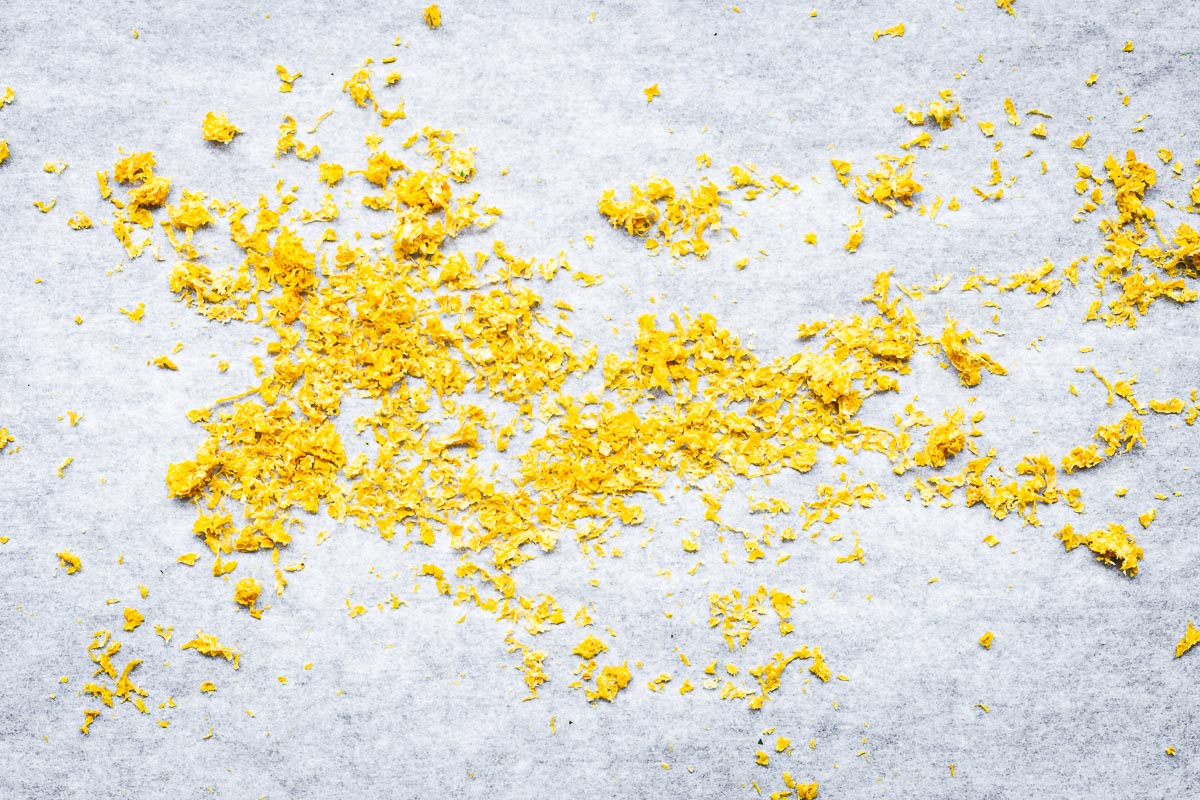
Whole slices of lemon peel take longer to dry, about two to three hours – which is why I prefer to dry the fine zest. But dried lemon peel has its purpose. It’s especially great as a garnish in drinks.
Check on the drying lemon peels every 20 minutes until it is hard and no longer bendy.
Air-dried lemon zest
Air-drying works best for fine lemon zest instead of whole pieces of lemon peel. Leave the paper-lined baking tray inside in a well-ventilated, warm spot.
Stir the zest every day until it is dry and shrivelled. It takes about a week, depending on the humidity where you live.
Want to speed up air-drying? Use residual oven heat from cooking.
Move the baking tray with lemon zest from its warm spot into your turned-off oven that is still hot. If the grated lemon peel is not dry once the oven is cool, return it to its sunny spot and repeat as necessary.
How to make dried lemon peel powder
Place your dried pieces of lemon peel or zest in a spice grinder.
Blitz it until the texture of the powder is to your liking.
How long does dried lemon zest last?
Transfer your dried zest, peel or dry lemon powder to an airtight container or spice jar.
Store it in a dark, dry space at room temperature. It will last up to one year, but I prefer to finish it in three months for optimal flavour.
However, the lemon rind is susceptible to mould if it is not completely dry. Discard the dried lemon skin at any sign of mould. And be sure to dry the skins for longer next time.
How to use dried lemon zest
Now that you know how easy it is to preserve lemon zest, you’ll also be happy to hear that you can add it to just about anything.
Here are a few easy, dried lemon zest recipe ideas to get you started.
Citrus salt
Mix your dried lemon zest with flaked sea salt for a super simple lemon seasoning. I use a 1:2 ratio of dry zest to salt flakes.
So, for every teaspoon of dried lemon zest, I add two teaspoons of sea salt flakes.
Why not add some mandarin or grapefruit zest for your own complex citrus salt? You can use the same method to dry the zest from mandarines, clementines, grapefruit or limes.
Little pots of citrus salt make great homemade gifts. It will last up to a year, but I prefer to use it within six months.
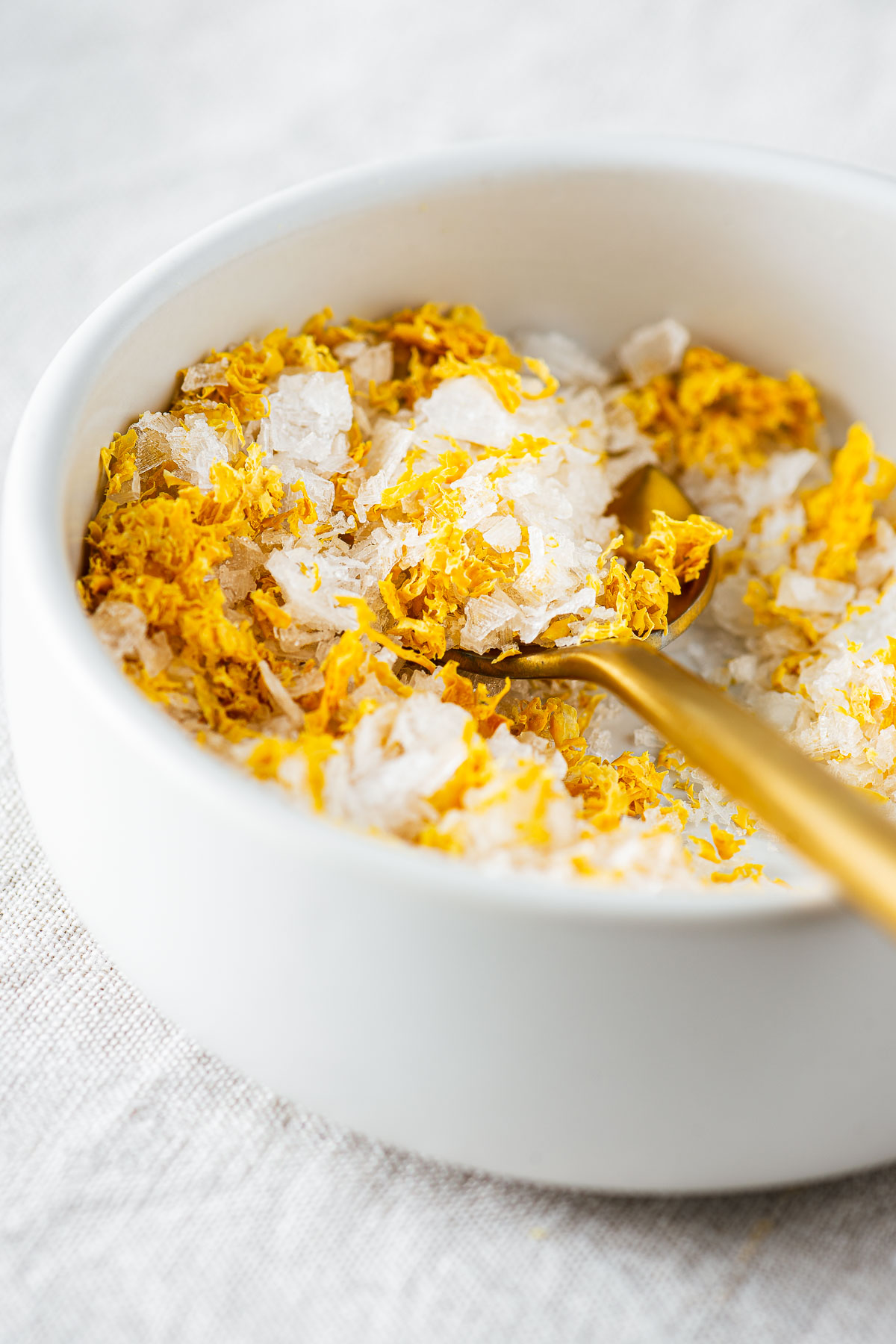
Lemon pepper seasoning
Add the dried lemon peel or zest from five lemons (about two heaped tablespoons of dried lemon zest) to a spice grinder with two tablespoons of whole black peppercorns and two teaspoons of salt. Blitz it into a powder.
I like a coarser lemon pepper seasoning, but you can keep going until it’s a fine powder.
Drinks garnish
Use a dried lemon peel to garnish your next gin and tonic. Or add it to a glass of sparkling water for a subtle lemon flavour.
Or use your homemade dried citrus zest for a citrus salt-rimmed cocktail:
- Mix a teaspoon of dried citrus zest and a teaspoon of salt on a small plate (or use homemade citrus salt).
- Crush any large salt flakes with the back of a teaspoon (if using flaky salt).
- Wet the rim of your glass with a clean fingertip.
- Twist and swirl the glass rim in the citrus salt until coated to your liking.
Salad dressings
Lemon zest, dried or fresh, adds a flavour boost to any salad dressing.
Use your dried lemon zest in classic salad dressings, or stir it into a tahini yoghurt dressing.
Make a quick lemon and herb salad dressing with dried lemon zest:
- ½ cup olive oil
- 2 tablespoons wine vinegar, red or white
- ½ teaspoon dried Italian seasoning (or 3 teaspoons chopped fresh herbs)
- 1 teaspoon dried lemon zest
- ½ teaspoon salt
Place all the ingredients in a mason jar (or any glass container with a tight-fitting lid). Tighten the lid, and shake vigorously.
Taste and adjust acidity and salt to preference.
Drizzle the dried lemon and herb dressing over a simple green salad, a more elaborate quinoa kale chickpea salad, or a herbed new potato salad.
Add dried lemon rind everywhere!
I use lemon zest in many recipes. And you can substitute dried lemon zest in any recipe that calls for fresh lemon zest.
Dried lemon zest is stronger than freshly grated lemon zest. Use roughly half the amount of dried lemon zest to substitute fresh zest.
Sprinkle it over zesty Arabic chopped salad, a tahini bulgur wheat salad, or anywhere in need of luscious lemony goodness.
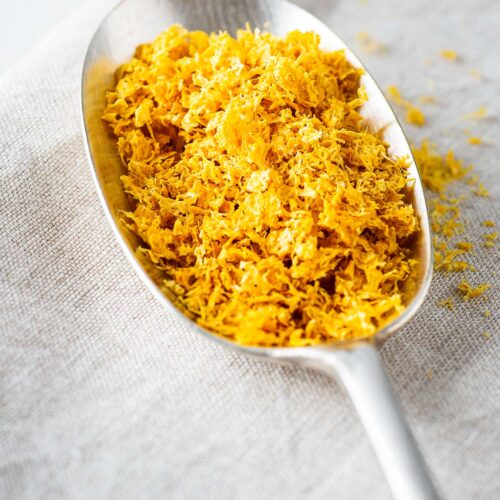
Ingredients
- 4 lemons*
Instructions
- Preheat your oven to 170 °F fan*. Or use your lowest oven setting.
- If you have waxed shop-bought lemons, rinse them with just boiled water (or very hot tap water) and scrub them with a vegetable brush to remove the wax. Or use a clean tea towel to rub off most of the wax. You can skip this step if you have unwaxed organic or homegrown lemons – just give them a rinse with cold water.
- Use a Microplane or the finest side of your box grater to remove the lemon zest. Alternatively, remove slices of lemon peel with a vegetable peeler. Try to get mostly yellow lemon skin and avoid too much white pith in your zest or lemon peels.
- Spread the lemon zest or peels on a parchment-lined baking sheet in a single layer. And place the baking tray in the centre of your preheated oven.
- Check on the zest after 30 minutes and stir. If it is not fully dried, return to the oven and check every 10 minutes. The yellow lemon zest will darken into orange, but it should not be brown. For me, this takes about 40 minutes. The whole lemon peels take longer to dry than lemon zest, about 2 to 3 hours – which is why I prefer to dry the fine zest. Check the drying lemon peels every 20 minutes or so.
- To make lemon peel powder, add the dried lemon zest or dried lemon peels to a spice grinder. And blitz it into a fine powder.
- Transfer your dried zest, peel or dry lemon powder to an airtight container or spice jar. Keep in a dark, dry space for up to one year.
Notes
- Use however many lemons you have. I dry lemon zest before I squeeze lemons for their juice, so I often dry the zest of only one lemon at a time. Four small lemons give roughly two tablespoons of dried lemon zest.
- If you don’t have a fan-assisted oven (convection oven), increase the temperature to 200 ºF (95 ºC).
- For air drying: Place the paper-lined baking tray in a well-ventilated, sunny spot inside the house. Stir the zest every few days until it is dry and shrivelled. It takes about a week, depending on the humidity. This method works best for fine lemon zest instead of large pieces of lemon rind.
- Boost your air drying with residual oven heat from cooking: Add the prepared baking tray with lemon zest or peel to your turned-off oven that is still hot. If the grated lemon peel is not fully dried by the time the oven is cold, return it to the sunny spot and repeat as necessary.
